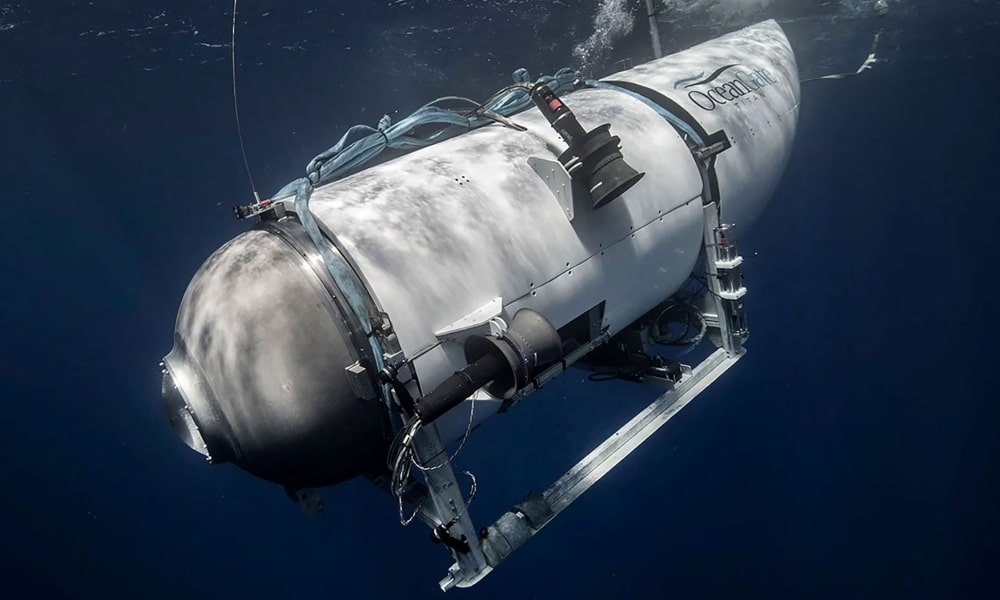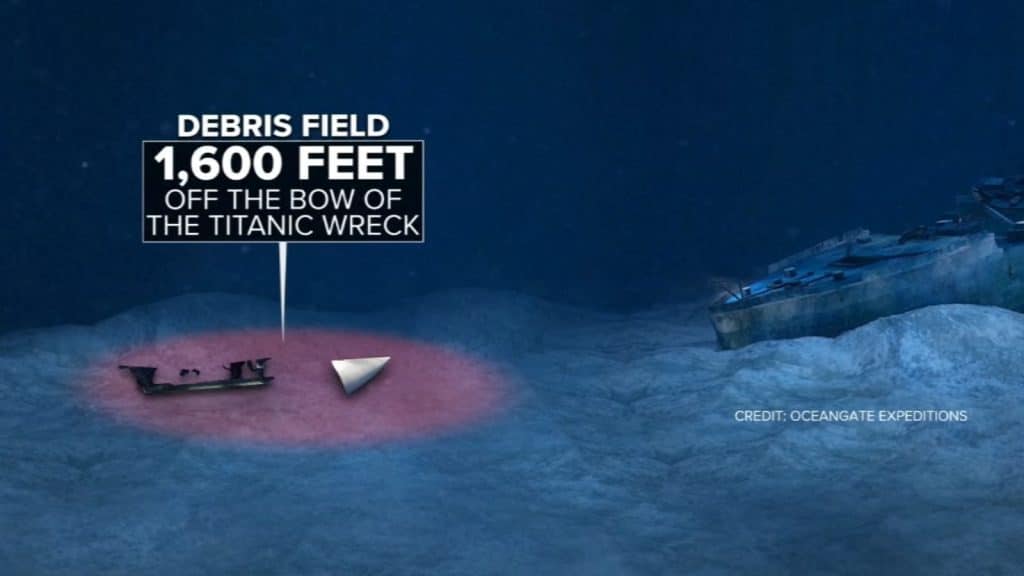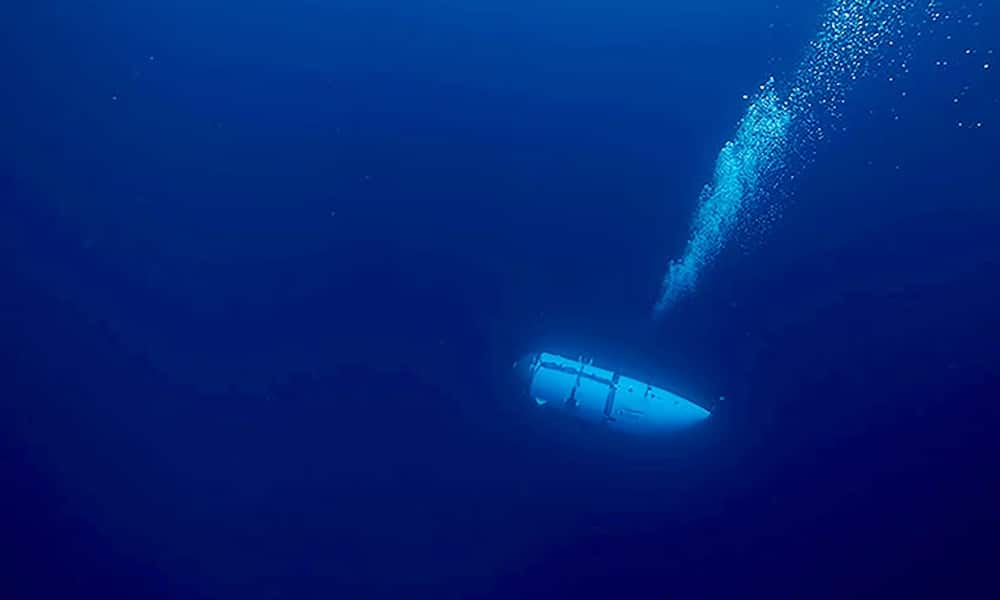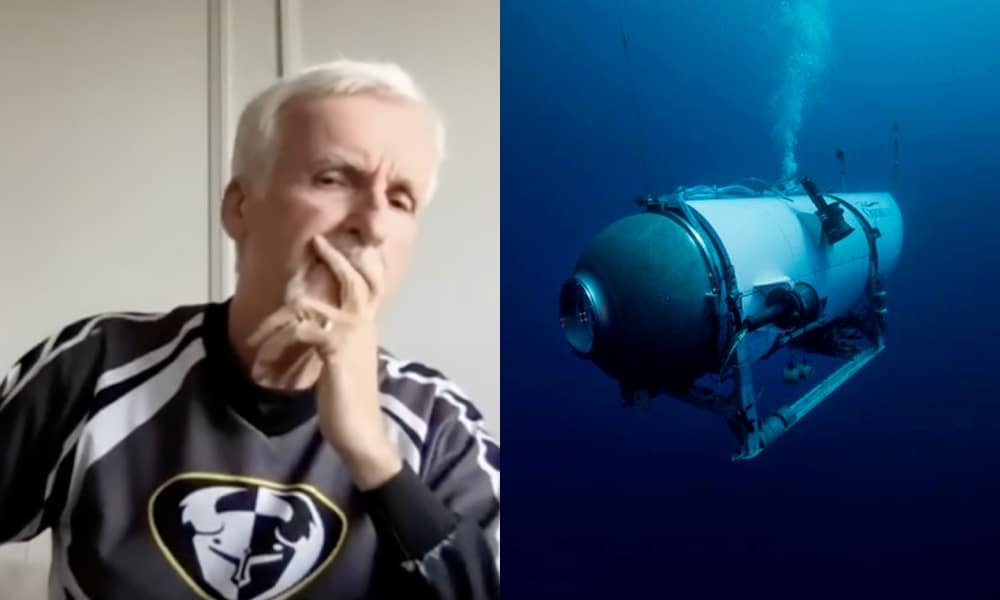Author: Gayety Staff
-

What Happens When a Submarine Implodes: The Titan Tragedy
Estimated reading time: 13 minutes
Table of contents
- What Happens When a Submarine Implodes? Understanding the Deadly Implications of a Submarine Implosion at Extreme Depths.
- A “Catastrophic Implosion”
- Remembering the Titan Crew
- Inside the Titan Submersible
- Uncovering the Debris of the Titan
- Implosion Evidence and Survivor Hopes
- Titan’s Safety Concerns and Track Record
- The World Watches: The Missing Submersible and the Titanic Legacy
- The Echo of the Titan in Deep-Sea Exploration
- A New Chapter in Oceanic Exploration
- FAQ: Understanding What Happens to a Human When a Submarine Implodes
- More Titan Stories
What Happens When a Submarine Implodes? Understanding the Deadly Implications of a Submarine Implosion at Extreme Depths.
In the unfathomable depths of the ocean, the weight of water presses down with crushing force. It’s a world where the pressure at 12,000 feet is a colossal 365 times greater than at sea level. A place where the unthinkable can happen: a submarine implosion.
A “Catastrophic Implosion”
Tragedy struck the ocean’s depth when the Titan, a submersible vessel, suffered a “devastating implosion”, as described by a U.S. Coast Guard spokesperson. The once-missing submersible was on a daring expedition to the Titanic wreckage, resulting in the loss of all five individuals on board.
The U.S. Navy detected the probable implosion of the missing Titan submarine hours before the U.S. Coast Guard announced it had disappeared. This revelation suggests the five-day search, which attracted constant media attention, may have been in vain from the onset. The Navy identified an anomaly consistent with an implosion in the same area where the Titan vanished. Despite this, the decision was made to continue the search and rescue mission.
The Titan, a Titanic-touring vessel, lost communication less than two hours into its dive, carrying four tourists and a pilot. After an extensive search operation, the submarine’s debris was found on the seafloor, and all aboard were declared dead. The cause of the implosion remains unknown, and there have been recent concerns about the safety record of OceanGate, the company behind the Titan, and the submarine’s ability to withstand deep-sea pressure.
Remembering the Titan Crew
According to the statement from OceanGate Expeditions, the US company that maintained the Titan, the five men on board were passionate adventurers and ocean explorers. The statement conveyed the company’s deep condolences, “Our hearts are with these five souls and every member of their families during this tragic time.”
Inside the Titan Submersible

The Telegraph - The Titan’s hull is constructed from five inches of robust carbon fiber, ensuring its resilience against the immense pressures found at the Titanic wreck depth.
- Equipped with four electric thrusters – a pair for horizontal movement and another for vertical navigation – the Titan is capable of reaching speeds of three knots.
- The pilot maneuvers the Titan using a device reminiscent of a conventional video game controller, bringing a familiar ease to undersea navigation.
- The Titan’s unique weight system enables it to descend as far as 2.4 miles below sea level. When it’s time to ascend, these weights can be discharged, prompting a smooth return to the surface.
- The crew’s toilet facility, albeit divided from the rest of the interior by a mere curtain, offers a breathtaking view through a 21-inch viewport, undoubtedly making for an unparalleled bathroom experience.
- Prior to any expedition, a titanium cap is meticulously bolted onto the Titan’s hull. This procedure guarantees the safety and security of its passengers, effectively sealing them inside until they make their return to the ocean’s surface.
The Titan submersible was equipped with a variety of notable features intended to facilitate deep-sea exploration. Its hull was constructed from five inches of carbon fiber, designed to endure the immense pressures at the depth of the Titanic wreck. It was outfitted with four electric thrusters — two for horizontal motion, two for vertical — which were intended to enable the submersible to reach speeds of up to three knots.
The pilot of the Titan would navigate using a modified video game controller, designed for intuitive control. To manage its depth, the Titan had a weight system that allowed it to sink up to 2.4 miles below the sea level; these weights could be released when it was time to ascend to the surface.
For the crew’s convenience, there was a toilet onboard, separated from the crew area by a simple curtain. This facility offered a unique view through a 21-inch viewport. Safety measures included a titanium cap that was bolted onto the hull before each expedition, sealing the passengers inside until they returned to the surface.
Uncovering the Debris of the Titan
In the early hours of Thursday, an unmanned vehicle, operated from a Canadian vessel, spotted the remains of the Titan. The wreckage was roughly 1,600 feet from the Titanic’s bow, more than two miles beneath the surface in the secluded North Atlantic region, stated U.S. Coast Guard Rear Admiral John Mauger during a press briefing.
“The debris field aligns with a significant implosion of the vehicle,” expressed Mauger. Among the deceased were British billionaire and adventurer Hamish Harding, 58; Shahzada Dawood, 48, a businessman of Pakistani origin and his son Suleman, 19, both British citizens; French oceanographer and Titanic connoisseur Paul-Henri Nargeolet, 77, who had visited the wreck multiple times; and Stockton Rush, the American CEO of OceanGate who was steering the submersible.

Credit: OceanGate Expeditions / ABC News Implosion Evidence and Survivor Hopes
Following the Titan’s communication breakdown with its support ship, various international rescue teams had been scouring thousands of square miles of sea with planes and ships for any trace of the 22-foot submersible.
Mauger declared it too soon to pinpoint when the submersible’s malfunction happened. Despite sonar buoys being active for over three days, they did not detect any explosive noises, according to Mauger. Certain sounds picked up on Tuesday and Wednesday sparked momentary hope that the passengers on the Titan were alive and attempting to communicate by striking the hull. However, officials confirmed that the origin of the noises remained uncertain, and they may not have come from the Titan at all. Mauger, on Thursday, shared that the correlation between the noises and the location of the debris field on the sea bed seemed unlikely.
Ocean floor robotic crafts will continue their investigation, Mauger confirmed, though recovery of the bodies might be impossible given the nature of the accident and the extreme conditions at those depths. Officials reported that they found five significant pieces of the Titan, including most of the pressure hull.
Titan’s Safety Concerns and Track Record
By Thursday, hope had started to wane with the 96-hour air supply in the Titan likely exhausted if the vessel had remained intact.
The Titanic, the infamous ship that sank on its maiden voyage in 1912 after striking an iceberg, rests approximately 900 miles east of Cape Cod, Massachusetts, and 400 miles south of St. John’s, Newfoundland. OceanGate has been conducting expeditions to the wreck since 2021, with each journey costing $250,000 per individual, according to OceanGate’s website.
In 2018, the Titan’s safety was questioned at a submersible industry expert symposium and a lawsuit by OceanGate’s former marine operations head, both settled later the same year.

The World Watches: The Missing Submersible and the Titanic Legacy
The extensive search, encompassing more than 10,000 square miles of ocean — roughly the size of Massachusetts — saw the use of two specialized deep-sea unmanned vehicles on Thursday. The perilous conditions at the ocean’s depths, with tremendous pressure and pitch-black darkness, made the mission challenging.
The missing submersible and the subsequent search drew global attention, partly due to the enduring mystique surrounding the Titanic. The supposedly “unsinkable” British passenger liner has been a source of fascination, inspiring both non-fiction and fiction tales for over a century, including the 1997 James Cameron blockbuster that reignited public interest in the story.
The Echo of the Titan in Deep-Sea Exploration
The loss of the Titan and its crew emphasizes the dangers of deep-sea exploration, even with modern technology and safety protocols. As the depth of the search grew, reaching to the abyss of the ocean, the task grew increasingly complicated due to the immense pressure, complete darkness, and vast expanse of the search area.
As for the Titan, its implosion adds a new chapter to the history of deep-sea exploration, serving as a stark reminder of the brutal conditions at those depths. It also underscores the need for rigorous safety measures and protocols, especially as explorers venture into largely uncharted territories of the deep sea.
Despite the tragedy, the spirit of exploration — the same spirit that drove the passengers of the Titan — continues to inspire. Their loss has left a significant impact on the oceanic exploration community, leaving a void that echoes through the dark, cold, and silent world they sought to understand.
The search for the Titanic, a relic of the past, has brought us face to face with the present reality of the risks involved in exploring the world’s last frontier. As investigators continue to unravel the events that led to this tragic incident, the world will be watching, hoping to learn valuable lessons for the future of deep-sea exploration.
In the face of great loss, the spirit of curiosity and discovery continues, undeterred by the unforgiving conditions of the ocean’s depth. It is a poignant reminder that the sea, for all its beauty and mystery, remains a realm that commands respect and caution. As we push the boundaries of human knowledge and capability, the tragic fate of the Titan and its crew will not be forgotten.
A New Chapter in Oceanic Exploration
This incident, coupled with the lasting allure of the Titanic’s story, serves as a potent reminder of the constant interplay between human ambition and the untamed force of nature. It emphasizes the importance of vigilance and respect for the environment we seek to explore, ensuring that the lives lost in this tragic event will continue to enlighten and guide future deep-sea explorations.
FAQ: Understanding What Happens to a Human When a Submarine Implodes
What is a submarine implosion?A submarine implosion occurs when the external pressure exerted by deep water becomes too great for the submarine’s structure to handle. This results in the submarine rapidly collapsing or “imploding.”
What happens to the human body during a submarine implosion?The exact events may vary, but the primary issues are the immense water pressure and rapid change in pressure. The pressure can cause air-filled spaces in the body to collapse, while rapid pressure changes can lead to decompression sickness. There are also risks of nitrogen narcosis, oxygen toxicity, and hypothermia.
What happens to the human body if a submarine implodes at 13,000 feet underwater?The immediate impact of an implosion at this depth is fatal. The extreme pressure differential would cause the air inside the submarine to heat up rapidly, causing severe burns. The human body would also be subject to traumatic injury due to the sudden change in pressure, resulting in an instantaneous or near-instantaneous death.
Can humans survive a submarine implosion at 13,000 feet underwater?Survival is nearly impossible in this scenario. The combination of immediate heat, rapid pressure changes, and the violent nature of an implosion makes it extremely unlikely for anyone to survive.
What happens to bodies left at the bottom of the ocean?At such depths, decomposition is slower due to the cold temperatures and lack of oxygen. However, scavenging sea creatures may feed on the remains. Over time, any remaining material is likely to be buried by sediment on the ocean floor.
What is decompression sickness and why does it occur?Decompression sickness, also known as “the bends,” occurs when a person ascends rapidly from high pressure to low pressure. The rapid pressure change causes dissolved gases, mainly nitrogen, in the bloodstream to form bubbles, causing severe joint pain, neurological damage, and potentially death.
What is nitrogen narcosis and oxygen toxicity?Nitrogen narcosis is a condition where high-pressure gases like nitrogen have a narcotic effect, causing a state of mental impairment similar to drunkenness. Oxygen toxicity occurs when the partial pressure of oxygen becomes too high, leading to seizures and other neurological effects.
How does deep-sea pressure affect the human body?Deep-sea pressure can have a “crushing” effect on the human body, causing potential tissue and organ damage. Air-filled spaces in the body such as lungs, ears, and sinuses may collapse or fill with body fluids to equalize pressure.
Is it possible for a human to survive a submarine implosion at extreme depths?It’s highly unlikely. The combination of immense pressure, rapid pressure changes, potential gas toxicity, and extremely cold temperatures would be fatal to a human exposed to such conditions.
What safety measures are in place to prevent submarine implosions?Modern submarines are designed and built to withstand extreme underwater pressure. They have reinforced hulls and special safety features like emergency ascent systems. However, the extreme depths and pressures of the deep sea can still pose serious risks. Regular maintenance, safety checks, and adherence to operational depth limits are crucial to ensure the safety of those onboard.
What causes a submarine to implode?A submarine implodes when it descends beyond its crush depth, the point at which the hull can no longer withstand the immense water pressure. This pressure imbalance can result from design flaws, equipment malfunction, or human error.
What happens to the submarine during an implosion?During an implosion, the external pressure becomes too great for the submarine’s structure. The submarine’s hull collapses inward rapidly, releasing an enormous amount of energy. This process occurs in milliseconds and reduces the submarine to a fraction of its original size.
What would happen to people inside a submarine during an implosion?An implosion at extreme depths would be instantly lethal for any people on board. The violent compression and subsequent shock wave leave no room for survival.
Is there any way to survive a submarine implosion?Given the rapidity and intensity of an implosion event, survival is virtually impossible. This is why stringent safety measures and operational guidelines are in place for submarine navigation to prevent such occurrences.
How can a submarine implosion be prevented?Preventing a submarine implosion primarily involves adhering to the vessel’s specified operational parameters, particularly its depth limit. Regular maintenance and checks of the submarine’s integrity, as well as correct responses to emergency situations, are also crucial in preventing implosions.
What are the after-effects of a submarine implosion?A submarine implosion releases a massive amount of energy, leading to shock waves that can damage nearby marine life and structures. The resulting debris field can also have a long-lasting impact on the surrounding marine environment.
Would a person inside an imploding submarine feel pain?Given the immediate and violent nature of a submarine implosion at this depth, it’s likely that death would be instantaneous, leaving no time to register pain.
Is there any protective gear or equipment that could increase survival chances during a submarine implosion?Given the extreme conditions and forces at 13,000 feet underwater, it is highly doubtful that any existing protective gear could significantly increase survival chances during an implosion. The best prevention is stringent safety measures and thorough equipment checks to ensure such an event doesn’t occur.
What is the difference between a submarine explosion and implosion?An explosion is when something bursts out because there’s too much pressure inside. Imagine a balloon popping. An implosion is when something collapses inward because there’s too much pressure outside. Picture a can being crushed. In a submarine, an explosion could happen if there’s a fire or too much gas builds up inside. An implosion could happen if a submarine goes too deep and the water pressure outside is much higher than inside.
When did the Titan submersible implode?The U.S. Navy detected the probable implosion of the missing Titan submarine hours before the U.S. Coast Guard announced it had disappeared on Sunday, June 18, 2023. The Navy identified an anomaly consistent with an implosion in the same area where the Titan vanished. Despite this, the decision was made to continue the search and rescue mission.
More Titan Stories
-

ICONIQA: A New Magazine Celebrating Queer Excellence
In the world of fashion and social media, Barry Brandon is certainly no stranger. Known for their consistent efforts towards LGBTQ+ visibility, Brandon is once again set to redefine queer narrative in the media with a new groundbreaking print magazine, “ICONIQA.”
A Platform Amplifying Queer Voices
Scheduled to launch in October 2023, ICONIQA will be a vibrant celebration of global queer excellence. Moreover, this publication aims to highlight the rich tapestry of queer identities. By featuring curated in-house and reader-submitted content, it seeks to break down barriers and amplify underrepresented voices in mainstream media.
“We champion diverse voices and unique perspectives from the global queer community in our magazine,” explains Barry Brandon, the visionary behind ICONIQA. “Furthermore, with every issue, we aim to ignite conversations, challenge norms, and inspire individuals.”
Related | Stunning New Portraits Capture Queer Beauty & Strength
Barry Brandon: A Trailblazer in Queer Representation
You may recognize Brandon from their viral appearances on queer TikTok. If you’re anything like us, you’ll remember the “MOVE OUT OF OUR WAY” video leaving you breathless. Regular readers here on Gayety may even remember Barry’s series of photos and videos that celebrated queer strength. The images, taken by Franco Dlp with the help of Sandra Quintero, captured a group of queer icons dressed in nothing but an elegant string of pearls. We also must not forget the First Queer Supper shoot, where ze gathered together even more queer creatives to create a gay depiction of Leonardo da Vinci’s famous Last Supper.
View this post on InstagramArmed with a wealth of experience, creativity, and passion, Barry Brandon brings a fresh perspective to ICONIQA. Her work consistently challenges conventions and redefines the status quo. With ICONIQA, Brandon aims to inspire and empower the queer community worldwide through increased visibility and self-expression. Clearly, Barry is more than ready to take the helm on an entirely new project at a much greater scale.
ICONIQA: From Barcelona Nightlife to Global Stage
ICONIQA had its humble beginnings as a queer dance party in Barcelona’s nightlife scene which debuted at the iconic Razzmatazz nightclub. It soon emerged as a celebration of queer joy and excellence, with performances from the likes of Violet Chachki. Now, with the help of local queer artists and global icons, it plans to extend its unique approach to other cities across Europe.
“Through ICONIQA, we believe in creating safer spaces for queer humans globally and view this as our platform for social change,” says Brandon. “ICONIQA is committed to celebrating queer diversity and brilliance from all corners of the globe.”
ICONIQA Magazine: A Showcase of Queer Culture
As a print publication, ICONIQA promises to be a vibrant showcase of contemporary queer art, fashion, and photography. Additionally, each issue aims to foster a deeper understanding of queer culture and its profound influence. The magazine is open to submissions from queer creatives worldwide, emphasizing its mission to amplify global queer voices.
Related | 20 Powerful Portraits Celebrating Body Positivity
Embracing the Spirit of Queer Excellence
ICONIQA combines fashion-forward editorials, engaging articles, and exclusive interviews with prominent figures from the global queer community. Indeed, it is an unapologetic celebration of queer identities, promoting individuality, expression, and empowerment.
“Visibility and self-expression are powerful tools,” shares Brandon. “They help us create safer spaces and platforms for social change. Thus, we are dedicated to celebrating the diversity and brilliance of queer individuals globally.” We are so excited to see what new surprised Barry has hidden up their couture sleeves.
For more information about ICONIQA, visit www.iconiqa.co.
-

8 Books for Baby Queers You Might Recommend to Someone These Days
This week’s book picks are dedicated to anyone who has ever googled: Am I gay?
-

Chris Hemsworth’s Sizzling ‘Commando’ Workout: Fans Can’t Help But Notice Thor’s Hammer
Chris Hemsworth’s Hammer: Thor Star’s ‘Commando’ Workout Video Sends Fans into a Frenzy! (more…)
-

Jai Rodriguez Heats Up Social Media with a Revealing Selfie
Jai Rodriguez’s Sizzling Selfie Stirs Up Social Media
-

‘Red, White & Royal Blue’ Movie: All You Need to Know – Cast, Release Date, and More
Red, White & Royal Blue Movie Poster Revealed.
-

30 Fiery Shots from Thomas Knights’ ‘Red Hot X’ Book
Red Hot X: A Daring Nude Male Art Book Celebrating Redheads.
Photographer Thomas Knights Reveals Stunning New Project
Renowned photographer Thomas Knights is set to release his latest art book, Red Hot X, a bold and daring hardback coffee table book featuring nude redhead males in stunning locations worldwide.

The Red Hot project, celebrating its 10-year anniversary, has sought to challenge taboos and defy the erasure of male redhead sexuality in media. The project showcases ginger beauty through calendars, art books, and exhibitions.

Red Hot X: A Daring Celebration of Ginger Beauty and Art
Renowned photographer Thomas Knights is once again pushing boundaries with his latest creation, Red Hot X, a hardback coffee table book that promises to be nothing short of extraordinary. This fine art collection celebrates redhead men in their most vulnerable, yet powerful form: nude. Marking the 10-year anniversary of Knights’ iconic Red Hot brand, Red Hot X invites us into an unparalleled journey through the beauty, strength, and rawness of ginger male nudes.

A World’s First: The Ginger Male Nude Art Book
In a realm where redheads often face unique challenges, Red Hot X stands as the world’s first and only ginger male nude art book. With a focus on celebrating the uniqueness of redhead men, the book showcases a diverse array of stunning models sourced from around the globe, all photographed by Knights. His work continues to break down stereotypes and redefine masculinity in bold new ways.

Through three exhilarating acts, Red Hot X presents models in daring and provocative settings, casting them in larger-than-life storylines that captivate the viewer’s imagination. The book draws from Knights’ biggest-ever global model search, bringing together an exciting mix of solos, group shots, and the unexpected—all laid out in rich, glossy detail across 144 pages.

The Art of Representation
For Knights, a ginger himself, this book is deeply personal. In an interview with Paulo Murillo, Editor in Chief of WEHO TIMES, Knights reflected on the unique challenges ginger men face. “Growing up ginger in the UK, there’s a lot of negative connotations. You get bullied for being ginger,” he shared. This project is not just about art; it’s about representation. By positioning ginger men as powerful, beautiful, and desirable, Red Hot X becomes a beacon of pride for those who have felt marginalized.

“We’re all about celebrating uniqueness, owning who you are, and being comfortable in your own skin,” Knights said, capturing the heart of the project.

A Work of Love—and Labor
Creating Red Hot X was no easy feat. Unlike the Red Hot calendars with their 12-month images, this new venture required the creation of 144 pages of content—each shot meticulously planned and executed. “We really pushed ourselves to create characters, storylines, different acts, and glamorous locations,” Knights explained. The result is a visually stunning world, affectionately dubbed “Gingerville” by the team—a place where redheads can finally feel like the stars of the show.

A Global Mission with Local Impact
In addition to being a collector’s masterpiece, Red Hot X also gives back. A portion of the book’s sales will support the Elton John AIDS Foundation, helping to provide treatment, fight stigma, and prevent HIV infections worldwide. Through this collaboration, Knights ensures that Red Hot X does more than celebrate beauty—it also stands for compassion, dignity, and community.

Red Hot’s Future
As for what’s next, Knights is already thinking ahead. “We’ll do another book sooner,” he teased in his interview. With Red Hot X poised to take the world by storm, it’s clear this won’t be the last time we see Knights’ innovative take on redhead representation.

Red Hot X isn’t just a book; it’s a movement, a celebration of identity, and an unapologetic love letter to ginger men worldwide. Whether you’re a fan of fine art, photography, or simply appreciate the beauty of redhead men, this limited-edition hardcover book promises to be a showstopper on any coffee table.

Red Hot X marks the first ginger male nude art book globally, showcasing sensational boys, outrageous settings, and exhilarating storylines in three acts. Act I, shot in the Algarve, transports readers to a world of crime, hedonism, and danger. Acts II and III will be shot in the UK and US, respectively.

For more information, visit www.redhot100.com. Scroll through some of our favorite shots from the collection below.


















More Stories
-

Meet Daniel Craig’s Lover Drew Starkey in Luca Guadagnino’s ‘Queer’
Drew Starkey and Daniel Craig Team Up in Luca Guadagnino’s ‘Queer’.
-

Jonathan Bennett Shares Thirst-Trap Photos That Sparked His Romance
Jonathan Bennett shares the captivating photos that started it all with his husband, Jaymes Vaughan. (more…)

